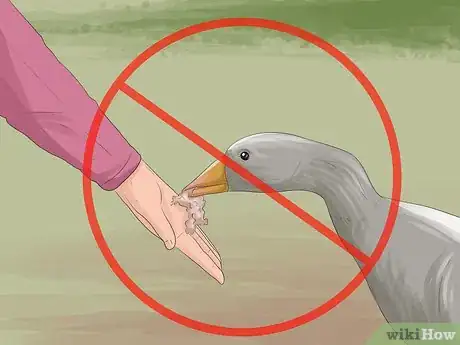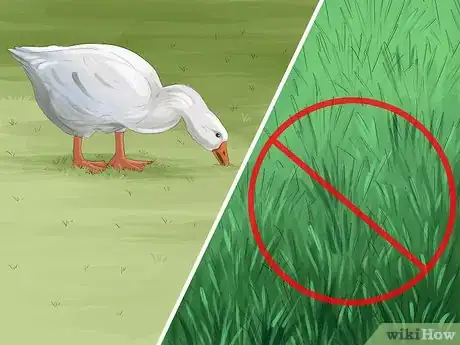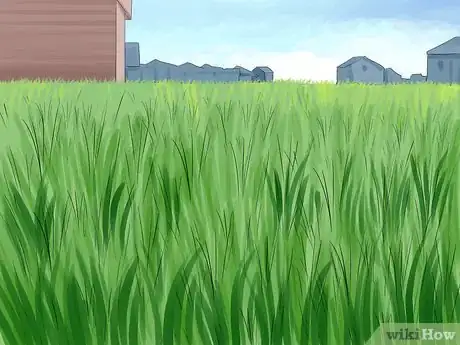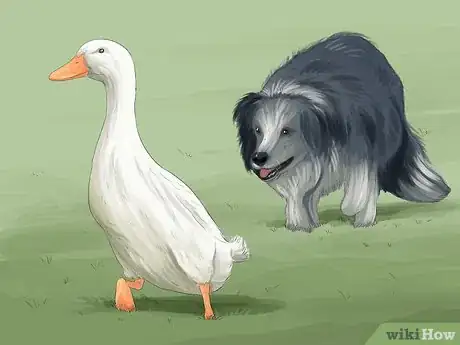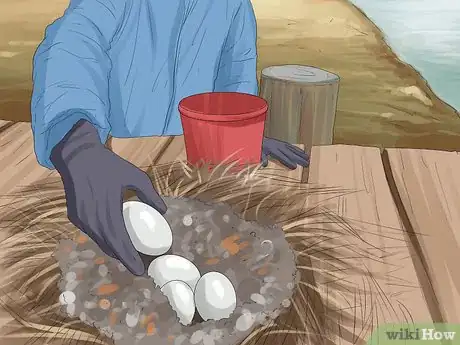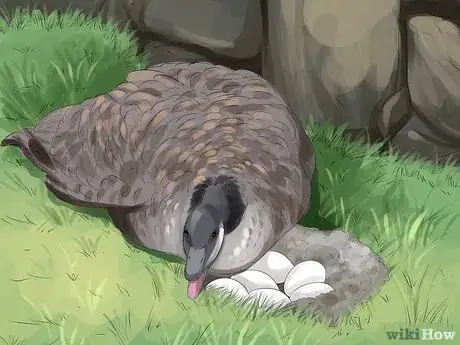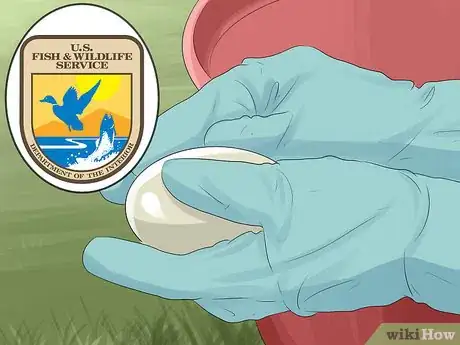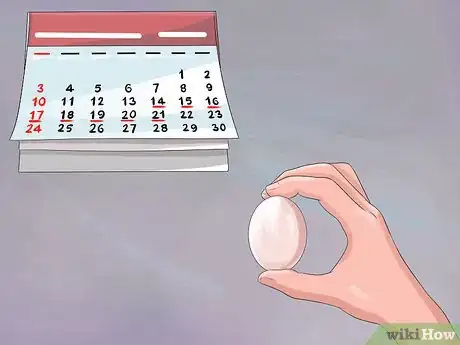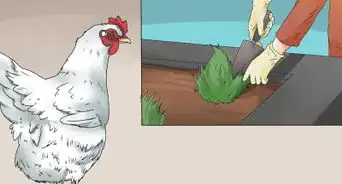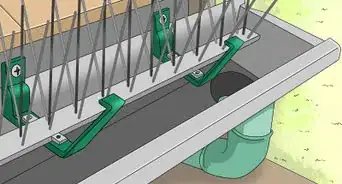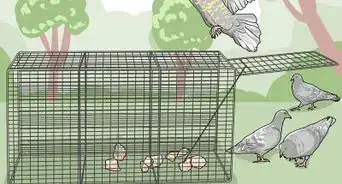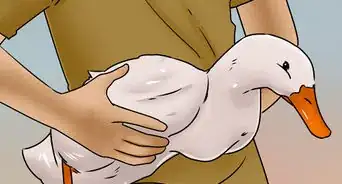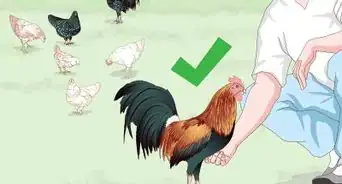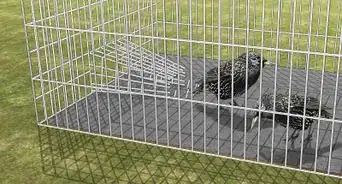wikiHow is a “wiki,” similar to Wikipedia, which means that many of our articles are co-written by multiple authors. To create this article, 17 people, some anonymous, worked to edit and improve it over time.
There are 9 references cited in this article, which can be found at the bottom of the page.
This article has been viewed 162,612 times.
Learn more...
Having geese on your property can be a nuisance. They create noise, leave droppings, and occasionally become aggressive. While many people enjoy feeding geese, this will only attract more to your area, leading to more problems. While some communities round up and kill geese, this is not necessarily a humane way to deal with an overpopulation of geese. There are several ways to deal with geese on your property. Removing their access to food, scaring them, and limiting their reproduction are all humane ways to deal with geese.
Steps
Changing the Habitat
-
1Avoid feeding geese. Feeding geese can attract more to your property. If they know they can get food from you, they will gather on your lawn.[1]
- Human food is not healthy for geese. Even if the geese are in a public place, such as a park, refrain from feeding them.[2]
- Geese are easily domesticated, especially if they are getting most of their food from you.[3]
- You may want to construct signage in your area letting others know not to feed the geese.[4]
-
2Remove any potential food sources. Geese will feed on grass as well as garbage. Make sure you dispose of your garbage properly, or keep it where geese cannot access it. If you have Kentucky Bluegrass planted in your lawn, consider replacing it with another grass.[5]
- Changing grasses may only work if there is another source of food for the geese. Geese will eat most short grasses and legumes if it is all that is available.[6]
- You may have to treat your grass with a chemical repellent, such as anthraquinone, which triggers digestive irritation in geese. There are several goose repellents available, many of which contain Methyl anthranilate, a chemical that makes grass taste bad to geese.[7]
Advertisement -
3Grow your grass taller. Geese like to feed on young grass shoots. By growing your grass taller, at least 6 inches, you may be able to get the geese to feed somewhere else.[8]
- Let your grass grow taller in the winter, and limit the amount of watering and fertilizing you do in the spring.[9]
- If you have a pond on your property, let the grass grow up to 20 inches to prohibit geese from gathering around it. Let the grass grow several feet across the property. Your property will look shaggy, but the geese will likely search for another nesting area.[10]
- Geese prefer open spaces where they can see predators and feel safe. Tall grasses disrupt this feeling of safety.[11]
Scaring Geese Away
-
1Use a goose-herding dog. Border collies and other herding breeds can be trained to scare geese away from an area. The geese will perceive the dog as a predator and may be convinced to leave the area for good.[12]
- Only dogs that have been specially trained by a handler should be used to scare geese away.[13]
- Do not let the dogs catch or harm the geese. If not specially trained, the dogs may cause the geese to re-locate to the water, where the dog will not pose a real threat.[14]
- If the geese are nesting or raising young, do not attempt to scare them away with a dog.[15]
-
2Use decoys and effigies for a temporary solution. There are several products on the market solely for the purpose of scaring geese, such as fake alligator heads or a plastic dead goose. Geese will eventually get used to these devices, but they may buy you some time to plan a more permanent solution.[16]
-
3Scare geese with loud noises. Sonic repellents can be effective at moving geese away from an area, but only for a short period of time. Most sonic repellents come equipped with a timer and make use of a recorded goose "alarm" call. When the geese hear the alarm, they flee.[19]
- Like decoys, sonic repellents may only work as a temporary solution. Geese can get used to loud noises rather quickly. Sonic repellents are much more effective if the geese associate the noise with a mobile threat, such as a dog or a person.[20]
Stabilizing Flock Growth
-
1Learn how to keep eggs from hatching. A humane way to prevent a growing flock of geese is a practice known as "addling." Goose eggs are treated with corn oil or removed from the nest entirely at the earliest stage of development.[21]
- Addling prevents geese from tending flightless goslings, and limits the number of geese in an area.[22]
- You must be properly trained to addle eggs. There are courses available online to guide you through the process.[23]
- You must register with the U.S. Fish and Wildlife Service before addling eggs. Some states require special permission aside from registering with the U.S.F.W.[24]
-
2Locate the nests. Geese nest near ponds and other bodies of water where they can have a good view of the area. Search near fence lines and other human-made barriers.[25]
- Geese often return to their nesting places from the previous year. Keep records of nest locations to make finding nesting areas easier.[26]
- Geese build oval nests out of vegetation, mulch, and other similar materials. Goose feathers on the ground may be a sign that a goose nest is close by.[27]
- Don't approach a nest alone. When approaching a goose nest, it is important to work in small teams of 3-4. Geese will actively, and aggressively, defend their territory.[28]
-
3Use corn oil to addle eggs. Coating eggs that are young enough (less than 14 days old) with corn oil prevents air from passing through the shell to the embryo.[29]
-
4Remove eggs from the nest. Another way to addle eggs is to remove them from the nest within the 14 day incubation time. Dispose of eggs according to the guidelines provided by the U.S.F.W.[32]
Community Q&A
-
QuestionHow can I clean up all the droppings?
 Community AnswerUse a water hose and put bleach on the spots where the geese go. This is what I did, and the geese didn't come back for a week.
Community AnswerUse a water hose and put bleach on the spots where the geese go. This is what I did, and the geese didn't come back for a week. -
QuestionWhat can I do if I am afraid of geese?
 Community AnswerAs someone who is also afraid of geese, I recommend simply avoiding them when you can.
Community AnswerAs someone who is also afraid of geese, I recommend simply avoiding them when you can. -
QuestionCan I throw firecrackers to scare geese?
 Community AnswerIf you're not concerned with being humane, you could, but it would be cruel and the geese could get hurt.
Community AnswerIf you're not concerned with being humane, you could, but it would be cruel and the geese could get hurt.
References
- ↑ http://www.humanesociety.org/animals/geese/tips/canada_geese_habitat.html?credit=web_id266485793
- ↑ http://www.getridofthings.com/pests/animals/get-rid-of-geese/
- ↑ http://www.wildlifeanimalcontrol.com/canadageese.html
- ↑ http://www.wildlifeanimalcontrol.com/canadageese.html
- ↑ http://www.humanesociety.org/animals/geese/tips/canada_geese_habitat.html?credit=web_id266485793
- ↑ http://www.humanesociety.org/animals/geese/tips/canada_geese_habitat.html?credit=web_id266485793
- ↑ http://www.humanesociety.org/animals/geese/tips/canada_geese_habitat.html?credit=web_id266485793
- ↑ http://www.humanesociety.org/animals/geese/tips/canada_geese_habitat.html?credit=web_id266485793
- ↑ http://www.humanesociety.org/animals/geese/tips/canada_geese_habitat.html?credit=web_id266485793
- ↑ http://www.wildlifeanimalcontrol.com/canadageese.html
- ↑ http://www.humanesociety.org/animals/geese/tips/canada_geese_habitat.html?credit=web_id266485793
- ↑ http://www.humanesociety.org/animals/geese/tips/canada_geese_scare_away.html?credit=web_id266485793
- ↑ http://www.humanesociety.org/animals/geese/tips/canada_geese_scare_away.html?credit=web_id266485793
- ↑ http://www.humanesociety.org/animals/geese/tips/canada_geese_scare_away.html?credit=web_id266485793
- ↑ http://www.humanesociety.org/animals/geese/tips/canada_geese_scare_away.html?credit=web_id266485793
- ↑ http://www.humanesociety.org/animals/geese/tips/canada_geese_scare_away.html?credit=web_id266485793
- ↑ http://www.humanesociety.org/animals/geese/tips/canada_geese_scare_away.html?credit=web_id266485793
- ↑ http://www.humanesociety.org/animals/geese/tips/canada_geese_scare_away.html?credit=web_id266485793
- ↑ http://pestkill.org/birds/geese/#Best-selling_repellents
- ↑ http://www.humanesociety.org/animals/geese/tips/canada_geese_scare_away.html?credit=web_id266485793
- ↑ http://www.humanesociety.org/animals/geese/tips/canada_geese_egg_addling.html?credit=web_id266485793
- ↑ http://www.humanesociety.org/animals/geese/tips/canada_geese_egg_addling.html?credit=web_id266485793
- ↑ http://www.humanesociety.org/animals/geese/tips/canada_geese_egg_addling.html?credit=web_id266485793
- ↑ http://www.humanesociety.org/animals/geese/tips/canada_geese_egg_addling.html?credit=web_id266485793
- ↑ http://www.humanesociety.org/assets/pdfs/WILD_Goose_Egg_Addling_Protocol.pdf
- ↑ http://www.humanesociety.org/assets/pdfs/WILD_Goose_Egg_Addling_Protocol.pdf
- ↑ http://www.humanesociety.org/assets/pdfs/WILD_Goose_Egg_Addling_Protocol.pdf
- ↑ http://www.humanesociety.org/assets/pdfs/WILD_Goose_Egg_Addling_Protocol.pdf
- ↑ http://www.humanesociety.org/assets/pdfs/WILD_Goose_Egg_Addling_Protocol.pdf
- ↑ http://www.humanesociety.org/assets/pdfs/WILD_Goose_Egg_Addling_Protocol.pdf
- ↑ http://www.humanesociety.org/assets/pdfs/WILD_Goose_Egg_Addling_Protocol.pdf
- ↑ http://www.humanesociety.org/assets/pdfs/WILD_Goose_Egg_Addling_Protocol.pdf
- ↑ http://www.humanesociety.org/assets/pdfs/WILD_Goose_Egg_Addling_Protocol.pdf
- ↑ http://www.humanesociety.org/assets/pdfs/WILD_Goose_Egg_Addling_Protocol.pdf
- ↑ http://www.humanesociety.org/assets/pdfs/WILD_Goose_Egg_Addling_Protocol.pdf
- ↑ http://pestkill.org/birds/geese/
About This Article
If geese keep landing on your property, there are a few different ways you can get them to leave and stop coming back. Try setting up predator decoys on your property, like fake alligator heads in bodies of water and fake dog cutouts. Move the decoys regularly so the geese don’t realize they’re fake. You can also apply a liquid bird repellent to the grass on your property to discourage geese from gathering there. Geese usually land in flat, wide-open areas where they can easily see potential predators, so planting tall shrubs or grasses that block their line of sight can help scare them off. If you have any bodies of water on your property, closing them off with a fence or other barrier will make geese less likely to land near them. Chasing away geese or scaring them off with loud noises whenever you see them may eventually get them to leave for good. While all of these methods will help get rid of geese on your property, make sure you’re not attempting to scare off geese that are nesting or raising young. Once their young are old enough to fly, then it’s okay to start deterring them again. To learn how you can use a specially-trained dog to scare away geese, read on!
